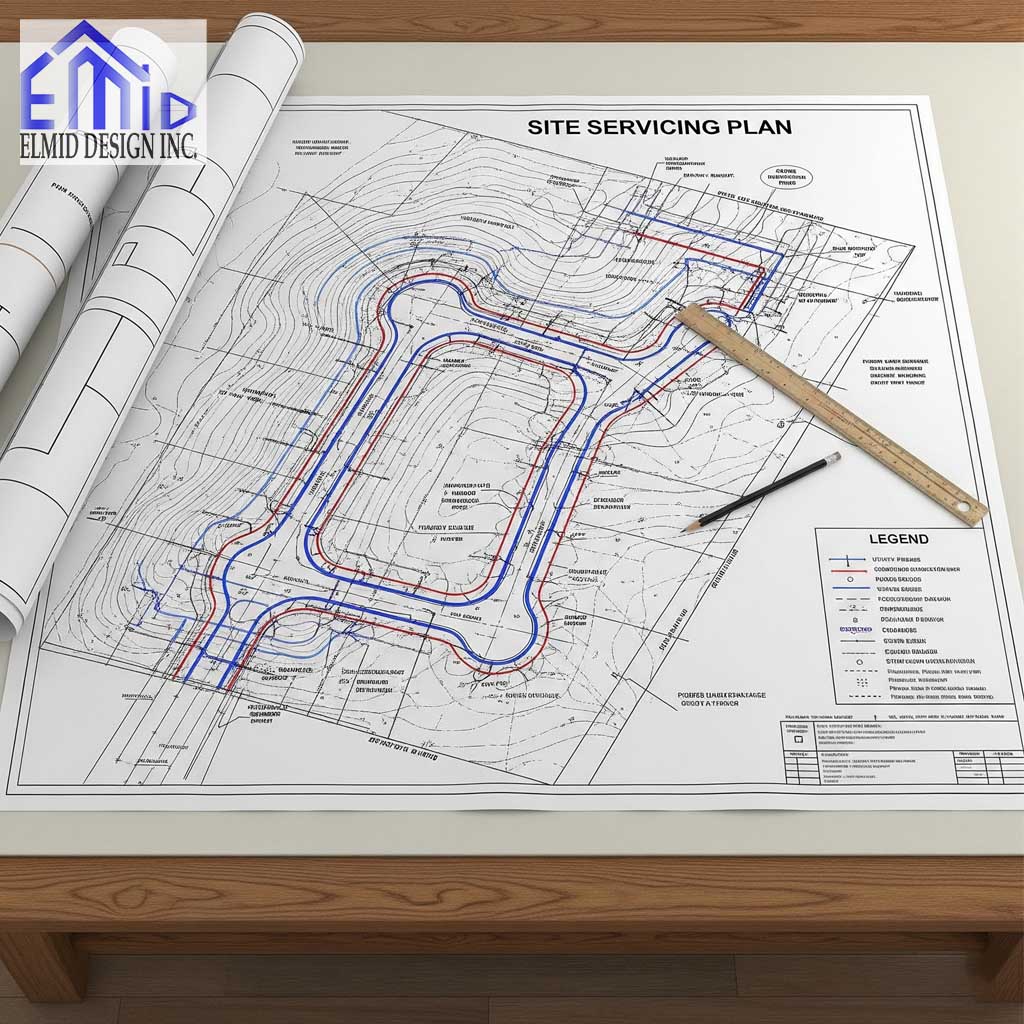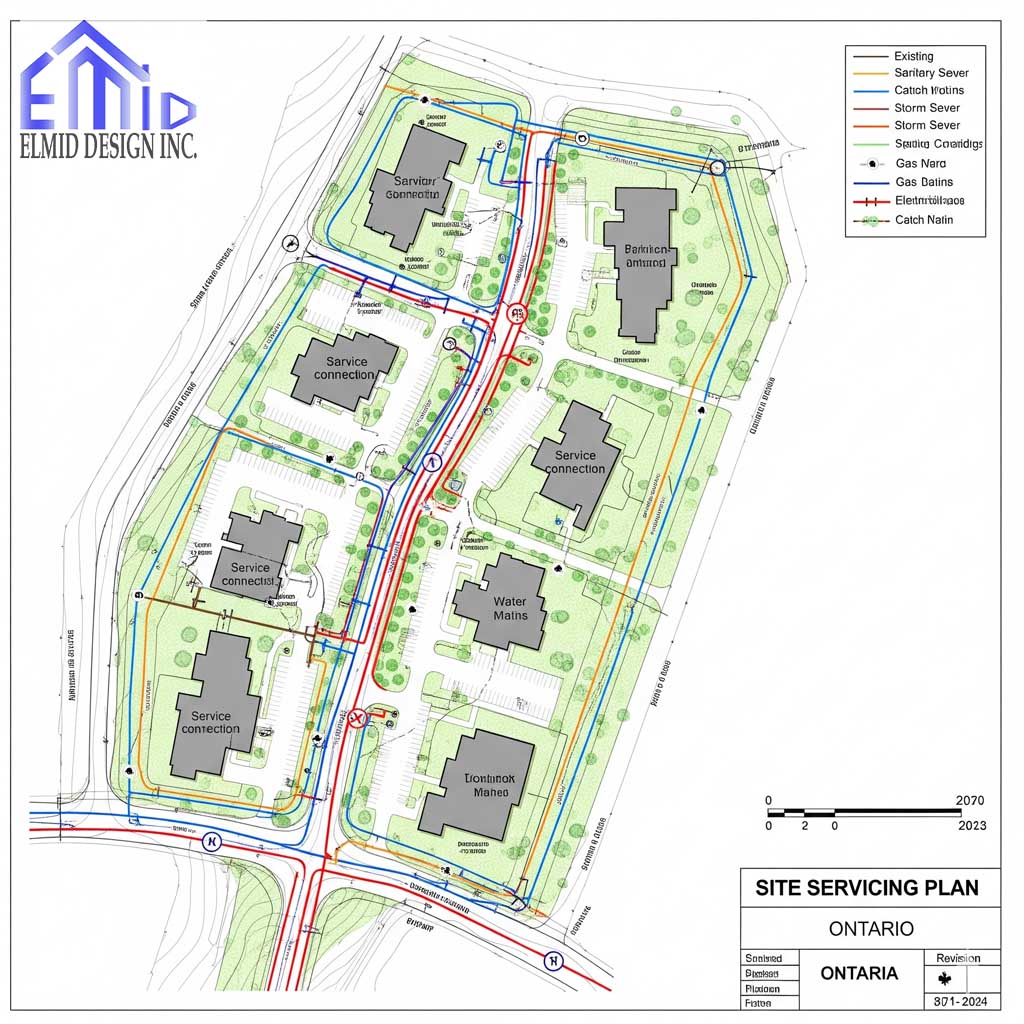A site servicing plan Ontario is one of the most important steps in preparing land for construction. Every new building project needs safe and reliable connections to water, sewer, storm drainage, and utilities. Without a proper plan, construction cannot move forward. Municipalities across Ontario require developers to submit detailed servicing drawings before they approve site plans or building permits. This process ensures that new projects can be supported by existing infrastructure and that future residents or businesses will have the services they need. By understanding how a site servicing plan works, builders, property owners, and engineers can avoid delays and costly mistakes during development.
Key Takeaways
A site servicing plan in Ontario outlines how a property connects to water, sewer, storm, and utilities.
Design must follow Ontario standards, municipal guidelines, and professional engineering requirements.
Elmid Design Inc, with a certificate of authorization from PEO, provides professional engineering services for preparing and reviewing site servicing plans.
What is a Site Servicing Plan in Ontario
A site servicing plan Ontario is a set of engineering drawings that show how a property will be connected to municipal services. The plan details the layout of water mains, sanitary sewers, storm sewers, and utilities such as gas, power, and telecommunications. It also includes information about grading, surface drainage, and access points. Municipal engineers review the plan to ensure the proposed connections meet capacity requirements and comply with local standards. Without this approval, a building permit cannot be issued. In simple terms, a site servicing plan is the bridge between a building design and the municipal infrastructure that supports it.
Legal and Planning Framework in Ontario
Every site servicing plan Ontario must comply with provincial and municipal planning laws. The Ontario Planning Act gives municipalities authority to regulate site development through site plan control. Local governments adopt engineering standards and guidelines that define how servicing systems are designed and connected. Conservation authorities also review stormwater management and drainage issues where natural features may be impacted. Municipal staff will not approve a building project until they confirm that the site servicing plan meets all these requirements. This legal framework ensures public health, safety, and environmental protection while allowing new developments to integrate with existing infrastructure.
When a Site Servicing Plan is Required in Ontario
Not every building project requires a full servicing study, but most medium and large developments do. A site servicing plan Ontario is required when a property needs new or upgraded water, sanitary, or storm connections. This typically applies to new subdivisions, commercial sites, industrial buildings, and multi-unit residential projects. Even small infill projects may require servicing drawings if they involve changes to existing utility connections or drainage patterns. Municipal staff often request a servicing plan during site plan approval or as part of a rezoning or subdivision application. Developers should confirm requirements with the city or region before submitting building permit applications.
Components of a Site Servicing Plan in Ontario
A site servicing plan Ontario includes several coordinated components that work together to ensure safe and reliable service delivery. The water system portion shows new water mains, service connections, fire hydrants, and pressure zones. The sanitary system outlines sewer pipes, manholes, slopes, and connection points to municipal sewers. The storm system includes storm sewers, catch basins, manholes, and outfalls, along with on-site stormwater management measures. Utility layouts illustrate the location of underground and above-ground services such as power, gas, and telecommunications. The grading plan shows proposed elevations, slopes, and drainage paths across the property. Together these elements provide a complete picture of how the site connects to the larger municipal system.
Design Criteria and Standards in Ontario
Each site servicing plan Ontario follows strict design standards to ensure safety, durability, and compatibility with municipal systems. Most municipalities adopt the Ontario Provincial Standards for Roads and Public Works, which govern materials, installation, and inspection procedures. Engineers maintain proper separation distances between water mains and sanitary sewers to protect water quality. They also design pipe sizes, slopes, and cover depths to meet capacity and frost protection requirements. Fire protection design follows the Ontario Building Code and Fire Code. Local municipalities may publish their own design manuals, which take precedence for site servicing within their boundaries. Licensed engineers under Professional Engineers Ontario prepare servicing plans and stamp all drawings before submission to confirm compliance.
Functional and Master Servicing Studies
For larger developments, a site servicing plan Ontario often includes support from a functional or master servicing study. A functional servicing study checks if municipal systems can handle the capacity needs of a new development by analyzing water pressure, sewer flows, and storm drainage at a broader scale. A master servicing study expands this review to cover entire subdivisions or community areas. Engineers use these studies to decide where new infrastructure is needed to support growth. Municipalities rely on the results before approving detailed servicing plans. By completing higher level servicing studies, engineers align individual site plans with regional infrastructure planning.
Stormwater Management and Drainage Design
One of the most critical aspects of a site servicing plan Ontario is stormwater management. Municipalities require developers to control both the quality and quantity of runoff leaving their site. Stormwater management facilities may include detention ponds, infiltration galleries, or underground storage tanks. These systems reduce flooding risk, protect water quality, and maintain natural drainage patterns. Drainage design must consider both the minor system, which handles frequent small storms, and the major system, which safely conveys extreme rainfall events. Conservation authorities review stormwater management reports to ensure protection of rivers, wetlands, and downstream properties. Without an approved drainage design, municipalities will not approve the servicing plan.

Water Supply Design and Fire Protection
A site servicing plan Ontario must show how the building connects to the municipal water system. Engineers calculate water demand based on building type, occupancy, and peak usage. The design must provide enough capacity for daily consumption and fire protection. Municipal standards require looping of water mains to avoid dead ends and maintain reliable pressure. Fire hydrants must be located within specific distances of buildings to allow access for emergency services. Flow tests are used to confirm that pressure and volume are available in the existing system. Without this confirmation, the municipality will not approve the plan.
Sanitary Sewer and Wastewater Design
The sanitary portion of a site servicing plan Ontario shows how engineers collect and convey wastewater to the municipal system. They design sewers based on dry weather flow, peak hourly flow, and allowances for infiltration. Engineers set slopes to keep solids moving without creating excessive velocity. They also place manholes at key intervals so inspectors can access and maintain the system. When gravity flow does not work, engineers design pumping stations or force mains to move wastewater effectively. Municipal staff confirm that the downstream system has enough capacity to manage new flows. Proper design protects public health and ensures compliance with environmental standards.
Utility Coordination in Site Servicing Plans
A complete site servicing plan Ontario also includes coordination of utilities such as hydro, gas, and telecommunications. Each utility provider has its own design requirements, but they must all be shown on the same plan to prevent conflicts. Engineers use standard separations and alignments to ensure that each service has enough space for installation and maintenance. Street lighting, traffic signals, and private services must also be considered. Utility coordination often requires meetings with multiple agencies to finalize layouts. Without this coordination, construction delays are common because of service conflicts. A properly prepared servicing plan prevents costly rework and ensures all providers can access their systems.
Grading and Surface Drainage
The grading plan is a key part of any site servicing plan Ontario. It establishes finished elevations for buildings, driveways, and landscaped areas. Grading must provide positive drainage away from structures and direct runoff to approved storm sewers or swales. Inter-lot drainage must be carefully designed to prevent flooding between properties. Grading also ensures that roadways and sidewalks meet municipal standards for slopes and accessibility. Proper grading reduces the risk of water damage and soil erosion. Municipal staff review grading plans closely because mistakes can affect not only the development site but also surrounding properties.
Easements and Legal Considerations
A site servicing plan Ontario often requires easements or rights-of-way to provide access to underground services. Easements act as legal agreements that give municipalities or utility providers the authority to enter private property for maintenance. The type and size of the service determine the required width of an easement. For example, large storm sewers may need wide easements to allow equipment access. Engineers show all easements on the plan and register them on the property title. These easements restrict future development because buildings cannot occupy those areas. Developers work with lawyers and engineers to secure these legal rights before construction begins.
Submission and Approval Process in Ontario
After preparation, the site servicing plan Ontario is submitted to the municipality for review. Engineering staff examine the drawings for compliance with standards and capacity requirements. Conservation authorities may review stormwater elements. Utility companies check the coordination of their systems. The review often involves several rounds of comments and revisions before approval. Once accepted, the plan becomes a condition of site plan approval or subdivision registration. Municipal inspectors then verify during construction that the work matches the approved drawings. Final acceptance is granted only after testing and certification by a licensed engineer. Without approval, no building permit can be issued.
Common Challenges in Site Servicing Plans
Developers often face challenges when preparing a site servicing plan Ontario. Existing municipal systems may not have enough capacity, requiring costly upgrades. Conflicts between utilities can force redesigns that delay schedules. Poor soil conditions may demand special construction methods. Environmental restrictions from conservation authorities may limit drainage options. Costs can rise quickly if new pumping stations or large stormwater facilities are needed. These challenges highlight the importance of early coordination with municipalities and utility providers. By addressing servicing issues at the start of the project, developers can avoid unexpected expenses and delays during construction.
Best Practices for Successful Site Servicing
Experienced engineers follow best practices when creating a site servicing plan Ontario. Early engagement with municipal staff ensures that design assumptions match local standards. Field investigations such as topographic surveys and utility locates provide accurate base information. Hydraulic models help predict system performance under peak conditions. Clear and coordinated drawings reduce confusion during construction. Professional oversight during installation ensures that work matches approved designs. Companies like Elmid Design Inc, licensed by Professional Engineers Ontario, apply these practices to deliver reliable and efficient servicing solutions. This professional approach protects clients from risk and ensures compliance with municipal requirements.
Case Study Example of Site Servicing Plan
Consider a commercial plaza development in southern Ontario. The engineer prepared a site servicing plan Ontario showing new water and sanitary connections, storm sewers, and grading. A functional servicing study confirmed that the nearby municipal system could handle increased flows. The team installed an underground storage tank to manage stormwater and reduce peak runoff. They positioned fire hydrants to meet fire code requirements and coordinated utility layouts with hydro and gas providers to prevent conflicts. Municipal staff reviewed the plan through several rounds of submissions and granted final approval. Construction then proceeded smoothly, and inspectors confirmed compliance. This example demonstrates how careful preparation leads to successful approvals and efficient construction.
Conclusion and Final Recommendations
A site servicing plan Ontario is more than a drawing. It is the foundation that connects every new building to municipal systems. Without a servicing plan, projects cannot proceed to construction. Developers must work with licensed engineers to prepare detailed servicing drawings that meet municipal and provincial standards. Early coordination with municipalities and utilities avoids costly delays. Proper stormwater management protects the environment and surrounding communities. Professional firms like Elmid Design Inc bring expertise and authorization from Professional Engineers Ontario to guide projects through approvals. For anyone planning a new development, investing in a well-prepared site servicing plan is essential for success.
Cost of Preparing a Site Servicing Plan in Ontario
The cost of a site servicing plan Ontario depends on project size, location, and complexity. Small infill projects may require limited drawings and cost less, while large subdivisions involve detailed studies, multiple utilities, and higher expenses. Fees also depend on the level of review required by municipalities and conservation authorities. Developers should budget not only for engineering design but also for surveying, approvals, and potential upgrades to municipal systems. Investing in a professional servicing plan reduces risks of redesign and construction delays, which can become more expensive than the initial design fees.
Timelines for Approval of Site Servicing Plans
Approval of a site servicing plan Ontario often takes several months. Municipal engineers must confirm compliance with standards, utility providers must review layouts, and conservation authorities must check environmental impacts. Revisions are common because review agencies provide comments that require updates to the drawings. Developers should plan for at least two to three submission cycles before final acceptance. Early coordination and complete submissions help reduce review time. Timelines also depend on municipal workload, so working with experienced engineers who know local requirements can speed up the approval process.
Municipal Differences Across Ontario
Each municipality in Ontario has unique standards and approval procedures for site servicing. A site servicing plan Ontario prepared for Mississauga may differ in format and detail from one in Ottawa or Oakville. Some cities require extensive hydraulic modeling, while others rely on simplified capacity checks. Grading requirements, stormwater criteria, and utility coordination also vary by region. Developers working across multiple municipalities must adapt their servicing plans to local expectations. Professional engineering firms familiar with different municipal standards help navigate these variations and ensure that servicing plans meet the specific requirements of each approval authority.
Site Servicing Plans for Residential Developments
Residential projects in Ontario often require detailed servicing plans to ensure that every home has safe and reliable connections. A site servicing plan Ontario for subdivisions includes layouts for water, sanitary, and storm systems that extend across the new community. Fire protection, storm water ponds, and grading for individual lots are shown on the drawings. Infill residential projects also require servicing plans, particularly when existing systems need upgrades to support additional units. Without these detailed engineering drawings, municipalities cannot confirm capacity, and developers risk delays in obtaining building permits.
Site Servicing Plans for Commercial and Industrial Projects
Commercial and industrial projects involve higher demands on municipal services, making servicing plans even more critical. A site servicing plan Ontario for a commercial plaza or factory must consider water demand, large sanitary flows, and stormwater management for paved areas. Fire protection systems often require higher water capacity, and large truck access impacts grading and road design. Utility coordination is also more complex, with larger power and gas requirements. Municipalities review these servicing plans carefully to ensure they do not overload existing infrastructure. Proper planning helps businesses open on schedule and avoid costly servicing delays.
Environmental Considerations in Site Servicing
Environmental protection plays a central role in every site servicing plan Ontario. Stormwater systems protect rivers, wetlands, and natural habitats from flooding and pollution. Engineers apply erosion and sediment control measures during construction to stop soil from washing into nearby waterways. Conservation authorities review plans to confirm that developments respect natural features and floodplain limits. Engineers also promote sustainable design techniques such as infiltration systems, permeable surfaces, and rainwater reuse, which municipalities in Ontario encourage more each year. By integrating environmental considerations into servicing plans, developers not only meet compliance requirements but also demonstrate a commitment to responsible building practices.
Role of Licensed Professional Engineers
Only licensed engineers can prepare and stamp a site servicing plan Ontario. Professional Engineers Ontario regulates the practice to protect the public interest. Engineers must apply technical knowledge, municipal standards, and safety principles to every design. Firms like Elmid Design Inc, with a certificate of authorization from PEO, provide assurance that servicing plans are prepared with accountability and professional oversight. This ensures that municipalities, developers, and future property owners can trust the reliability of the servicing systems. Engaging qualified professionals is not just a requirement; it is a safeguard for the success of any building project.
Comparison of Site Servicing and Grading Plans
A site servicing plan Ontario and a grading plan often work together but serve different purposes. The servicing plan shows the layout of underground and above-ground utilities that connect a property to municipal systems. The grading plan shows finished elevations and surface drainage across the site. Both are reviewed by municipal staff, and one cannot function properly without the other. For example, storm sewers designed in the servicing plan must align with drainage patterns shown in the grading plan. Together, they create a complete picture of how the site will be prepared for safe and efficient use.
Future Trends in Site Servicing Plans
The future of site servicing plan Ontario design is moving toward sustainability and technology integration. Municipalities are adopting stricter stormwater management policies to address climate change and flooding risks. Engineers are using advanced software and 3D modeling to prepare more accurate and coordinated servicing plans. Green infrastructure such as bioswales, rain gardens, and permeable pavements is being added to traditional servicing systems. These innovations reduce environmental impact while maintaining functionality. Developers who adopt forward-looking servicing practices position themselves to meet evolving municipal standards and public expectations for sustainable development.
Importance of Site Servicing in Building Success
The success of any building project in Ontario depends on the quality of its servicing plan. A site servicing plan Ontario ensures that new developments have the essential services needed for safe operation. Without proper servicing, buildings cannot function and permits cannot be issued, and construction cannot proceed. Developers who invest in professional servicing design avoid costly mistakes and delays. Municipalities rely on these plans to confirm that growth is sustainable and safe for communities. A well-prepared servicing plan transforms a building design from concept to reality by connecting it seamlessly to municipal infrastructure.
Frequently Asked Questions
What is included in a site servicing plan in Ontario
A site servicing plan Ontario includes water, sanitary, storm, grading, and utility layouts. It also shows easements, access points, and connections to municipal systems.
Who can prepare a site servicing plan in Ontario
Only licensed professional engineers with a certificate of authorization from Professional Engineers Ontario can prepare and stamp a site servicing plan.
When is a site servicing plan required
A site servicing plan Ontario is required for new developments, major redevelopments, and projects involving new or upgraded service connections.
How long does approval take
Municipal review of a site servicing plan Ontario can take several months. Timelines depend on project complexity and the number of review agencies involved.
Why is stormwater management included in a servicing plan
Stormwater management protects downstream systems, prevents flooding, and ensures compliance with environmental regulations. It is a mandatory part of every site servicing plan Ontario.

Elmid Design Inc: Trusted Experts in Site Servicing Plans
Elmid Design Inc is a professional engineering firm in Ontario with a certificate of authorization from Professional Engineers Ontario. The company specializes in preparing and reviewing site servicing plan Ontario projects, ensuring compliance with municipal standards and provincial regulations. With expertise in water, sanitary, stormwater, grading, and utility coordination, Elmid Design Inc provides reliable solutions for residential, commercial, and industrial developments. By combining technical precision with local knowledge, the firm helps clients achieve timely approvals and successful construction outcomes while maintaining the highest standards of safety and environmental responsibility.
Geographic Locations That We Service:
Our Licensed Professional Engineers specializing in Engineered Site Grading Plans offer the best-engineered site grading plan, lot grading and erosion plan, and drainage plan to obtain site plan approval and building permits in Ontario, including a wide range of municipalities. Each area boasts unique features and requirements, making our tailored approach essential for success.
Toronto and Surrounding Areas
In the vibrant heart of Ontario, we service Toronto (City of Toronto) and surrounding areas. Additionally, we cover Oshawa (City of Oshawa), Pickering (City of Pickering), and Clarington (Municipality of Clarington). Furthermore, our expertise extends to Ajax (Town of Ajax), Whitby (Town of Whitby), Brock (Township of Brock), Scugog (Township of Scugog), and Uxbridge (Township of Uxbridge).
Halton Region
Moving to the Halton Region, our services encompass Burlington (City of Burlington) and Halton Hills (Town of Halton Hills). Also included are Milton (Town of Milton) and Oakville (Town of Oakville).
Peel Region
In the Peel Region, we provide services in Brampton (City of Brampton), Mississauga (City of Mississauga), and Caledon (Town of Caledon).
York Region
Our services in the York Region cover Vaughan (City of Vaughan), Aurora (Town of Aurora), and East Gwillimbury (Town of East Gwillimbury). We also cater to Georgina (Town of Georgina), Markham (City of Markham), Newmarket (Town of Newmarket), Richmond Hill (City of Richmond Hill), Whitchurch-Stouffville (Town of Whitchurch-Stouffville), King (Township of King), and Bradford-West Gwillimbury (Town of Bradford-West Gwillimbury). Each municipality here offers a distinct setting, requiring our specialized approach.
Other Southern Ontario Cities and Towns
We also serve many other cities and towns in Southern Ontario. These include Hamilton (City of Hamilton), St. Catharines (City of St. Catharines), Niagara on the Lake (Town of Niagara on the Lake), Brant (County of Brant), Cambridge (City of Cambridge), Kitchener (City of Kitchener), Waterloo (City of Waterloo), and Woodstock (City of Woodstock). Furthermore, we operate in Guelph (City of Guelph), Centre Wellington (Township of Centre Wellington), Shelburne (Town of Shelburne), Orangeville (Town of Orangeville), New Tecumseth (Town of New Tecumseth), Essa (Town of Essa), Collingwood (Town of Collingwood), Wasaga Beach (Town of Wasaga Beach), Barrie (City of Barrie), Midland (Town of Midland), Orillia (City of Orillia), Ramara (Town of Ramara), Minden Hills (Town of Minden Hills), North Kawartha (Town of North Kawartha), Kawartha Lakes (City of Kawartha Lakes), Peterborough (City of Peterborough), Selwyn (Town of Selwyn), and Brighton (Municipality of Brighton).




